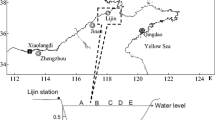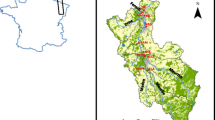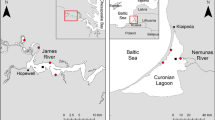Abstract
We examined particle size distributions of suspended particulate matter (SPM); physical and environmental influences on the observed distributions; and relationships between particle size and geochemical partitioning of metals, over the fall and winter period in a small urban river (Don River, Toronto, Ontario, Canada). For this dataset, the majority of particles (80%) in suspension were less than 10 µm in size. In addition, while total SPM concentrations showed a positive trend with increasing discharge (Q); the proportions of particles found within given size classes were independent of both SPM concentration and Q. Temperature was the only measured environmental variable related to the particle concentrations within size classes. As water temperature increased, the concentration of particles in the smallest size class (1–4 µm) decreased, while the concentration of silt and/or algae sized particles (10–50 µm) increased. Increasing water temperatures may promote bacterial attachment to particles and their subsequent flocculation into larger sized particles. Decreasing concentrations of leachable (most labile) Cd, Zn and Mn were associated with increasing concentrations of the largest particles (70–150 µm) in suspension. In contrast, higher reducible (oxides) associated concentrations of Cd, Zn and Mn occurred with increasing concentrations of smaller particles (1–10 µm) in suspension. Both of these trends are speculated to reflect the importance of particle surface area for metal sorption reactions.
Similar content being viewed by others
References
Balikungeri A. and W. Haerdi, 1988. Complexing abilities of hydrous manganese oxide surfaces and their role in the speciation of heavy metals. Intern. J. Environ. Anal. Chem. 34:215–225.
Beckett R., G. Nicholson, B.T. Hart, M. Hansen and J.C. Giddings, 1988. Separation and size characterization of colloidal particles in river water by sedimentation field-flow fractionation. Wat. Res. 22:1535–1545.
Beveridge T.J., S.S. Rao, S.A. Daniels and C.M. Taylor, 1993. Suspended particulate research: current approaches and future needs. In S.S. Rao (ed.)Particulate Matter and Aquatic Contaminants CRC Press, Lewis Publ., Boca-Raton pp. 197–205.
Buffle J., A. Tessier and W. Haerdi, 1984. Interpretation of trace metal complexation by aquatic organic matter. In C.J.M. Kramer and J.C. Duinker (eds.)Complexation Of Trace Metals In Natural Waters Junk Publ., The Hague. pp. 301–316.
Campbell P.G.C. and A. Tessier, 1989. Geochemistry and bioavailability of trace metals in sediments. In A. Boudou and F. Ribeyre (eds.)Aquatic Ecotoxicology CRC Press, Boca Raton. pp. 125–148.
Dickinson T., 1987. Sediment transport in Ontario Streams. In J. FitzGibbon and P. Mason (eds.)Managing Ontario's Streams Canadian Water Resources Association. pp. 40–59.
Dzombak D.A. and F.M.M. Morel, 1990.Surface Complexation Modelling. Hydrous Ferric oxide. Wiley-Interscience, New York. 331 pp.
Dzombak D.A. and F.M.M. Morel, 1986. Sorption of cadmium on hydrous ferric oxide at high sorbate/sorbent ratios: equilibrium, kinetics and modelling. J. Colloid Interface Sci. 112:588–598.
Evans L.H., 1989. Chemistry of metal retention by soils. Environ. Sci. Technol. 23:1047–1056.
Filipek L.H. and R.M. Owen, 1979. Geochemical associations and grain-size partitioning of heavy metals in lacustrine sediments. Chem. Geol. 26:105–117.
Guy R.D., C.L. Chakrabarti and L.L. Schramm, 1975. The application of a simple chemical model of natural waters to metal fixation in particulate matter. Can. J. chem. 53:661–669.
Horowitz A.J., 1991.Sediment-Trace Element Chemistry 2nd. Lewis Publishers, Chelsea, MI.
Horowitz A.J., F.A. Rinella, P. Lamothe, T.L. Miller, T.K. Edwards, R.L. Roche and D.A. Rickert, 1990. Variations in suspended sediment and associated trace element concentrations in selected riverine cross sections. Environ. Sci Technol. 24:1313–1320.
Huang W.W. and J. Zhang, 1990. Effect of particle size on transition metal concentrations in the Chanjiang (Yangtze River) and the Huanghe (Yellow River), China. Sci. Total Env. 94:187–207.
Jenne E.A., V.C. Kennedy, J.M. Burchard and J.W. Ball, 1980. Sediment collection and processing for selective extraction and for total trace element analyses. In R.A. Baker (ed.)Contaminants and Sediments Vol. 2. Ann Arbor Science: Ann Arbor. pp. 169–190.
Johnson C.A., 1986. The regulation of trace element concentrations in river and estuarine waters contaminated with acid mine drainage: The adsorption of Cu and Zn on amorphous Fe oxyhydroxides. Geochim. Cosmochim. Acta. 50:2433–2438.
Knighton D., 1984.Fluvial Forms and Processes. Edward Arnold Publ.: London. 218 pp.
Laxen D.P.H., 1985. Trace metal adsorption/coprecipitation on hydrous ferric oxide under realistic conditions. Wat. Res. 19:1229–1236.
Lövgren L. and S. Sjöberg, 1989. Equilibrium approaches to natural water systems — 7. Complexation reactions of copper(II), cadmium(II) and mercury(II) with dissolved organic matter in a concentrated bog-water. Wat. Res. 23:327–332.
Luoma S.N., 1983. Bioavailability of trace metals to aquatic organisms — a review. Sci. Total. Environ. 28:1–23.
Martincic D., Z. Kwokal and M. Branica, 1990. Distribution of zinc, lead, cadmium and copper between different size fractions of sediments I. The Limski Kanal (North Adriatic Sea). Sci. Total Env. 95:201–215.
Martell A.E., R.J. Motekaitis and R.M. Smith, 1988. Structure-stability relationships of metal complexes and metal speciation in environmental aqueous solutions. Environ. Toxic. Chem. 7:414–434.
Mudroch A. and G.A. Duncan, 1986. Distribution of metals in different size fractions of sediment from the Niagara River. J. Great Lakes Res. 12:117–126.
Ongley E.D., B.G. Krishnappan, I.G. Droppo, S.S. Rao and R.J. Maguire, 1992. Cohesive sediment transport; emerging issues for toxic chemical management. Hydrobiol. 235:177–187.
Palmateer G.A., D.E. McLean, W.L. Kutas, and S.M. Meissner, 1993. Investigations of suspended particulate-bacterial interaction in agricultural drains. In S.S. Rao (ed.)Particulate Matter and Aquatic Contaminants CRC Press, Lewis Publ., Boca-Raton. pp. 1–40.
Pomeroy L.R. and D. Deibel, 1986. Temperature regulation of bacterial activity during the spring bloom in Newfoundland coastal waters. Science 233, 359–361.
Rao S.S., I.G. Droppo, C.M. Taylor and B.K. Burnison, 1991.Freshwater Bacterial Aggregate Development: Effect of Dissolved Organic Matter. National Water Research Institute Contribution No. 91-75, Canada Centre for Inland Waters, Burlington, Ontario.
SAS Institute Inc., 1987. SAS/STAT Guide for Personal Computers Version 6. SAS Institute, Cary N. Carolina.
Tessier A., Y. Couillard, P.G.C. Campbell and J.C. Auclair, 1993. Modelling Cd partitioning in oxic lake sediments and Cd concentrations in the freshwater bivalveAnodonta grandis. Limnol. Oceanogr. 38:1–17.
Tessier A., P.G.C. Campbell and M. Bisson, 1982. Particulate trace metal speciation in stream sediments and relationships with grain size: implications for geochemical exploration. J. Geochem. Explor. 16:77–104.
Tessier A., P.G.C. Campbell and M. Bisson, 1980. Trace metal speciation in the Yamamaska and St. Francois Rivers (Quebec). Can. J. Earth Sci. 17:90–105.
Tessier A., P.G.C. Campbell and M. Bisson, 1979. Sequential extraction procedure for the speciation of particulate trace metals. Anal. Chem. 51:844–851.
Walling D.E. and P.W. Moorehead, 1989. The particle size characteristics of fluvial suspended sediment: an overview. Hydrobiol. 176/177:125–149.
Warren L.A. and A.P. Zimmerman, 1994a. The influence of temperature and NaCl on cadmium, copper and zinc partitioning among suspended particulate and dissolved phases in an urban river. Wat. Res. 28:1921–1931.
Warren L.A. and A.P. Zimmerman, 1994b. The importance of surface area in metal sorption by oxides and organic matter in a heterogeneous natural sediment. Appl. Geochem. 9:245–254.
Warren L.A. and A.P. Zimmerman, 1993. Trace metal/SPM associations in a fluvial system: physical and chemical influences. In: S.S. Rao (ed.)Particulate Matter and Aquatic Contaminants, CRC Press, Lewis Publ. Boca Raton, pp. 127–155.
Zar J.H., 1984.Biostatistical Analysis. 2nd. Ed. Prentice-Hall, New Jersey.
Author information
Authors and Affiliations
Rights and permissions
About this article
Cite this article
Warren, L.A., Zimmermann, A.P. Suspended particulate grain size dynamics and their implications for trace metal sorption in the Don River. Aquatic Science 56, 348–362 (1994). https://doi.org/10.1007/BF00877181
Received:
Accepted:
Issue Date:
DOI: https://doi.org/10.1007/BF00877181




